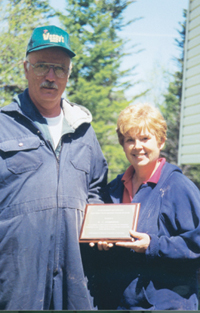
Features
Production
Research
Couple tackle you-pick operation in Newfoundland
you-pick operation in Newfoundland
April 15, 2008 By Coralie Adams
Newfoundlanders eat turnips and
lots of them. In fact, seven times the Canadian average, according to
K. C. Robertson. K. C. and his wife Sandra own and operate Robertson’s
U-Pick, near Lethbridge, Newfoundland.
 |
| K.C. and Sandra Robertson operate Robertson’s U-Pick near Leth-bridge, Newfoundland. Here, the couple hold a plaque presented to them by the Newfoundland & Labrador Federation of Agriculture in recognition of achievement and dedication for outstanding contribution to the common goal of environmental sustainability in the agri-food sector. Photo by Coralie Adams. |
Newfoundlanders eat turnips and lots of them. In fact, seven times the Canadian average, according to K. C. Robertson. K. C. and his wife Sandra own and operate Robertson’s U-Pick, near Lethbridge, Newfoundland.
In 1975, the couple started with a 70-acre farm and, since then, have increased their holdings to 200 acres. The original cleared planting area was 15 acres and, by 2003, had increased to 70 acres. As both the Robertson’s were full-time schoolteachers (K.C. for 20 years and Sandra for 22 years) the you-pick business was initially strawberries, which kept them and their family busy from mid-July until mid-August. Now, the steadily growing farm fully occupies them and their staff from seeding in April until putting the fields to bed in October.
Currently, the Robertson’s employ five full-time seasonal workers plus ten occasional or casual workers as need demands. K.C. says they provide four and a half weeks of employment per cultivated acre.
The Robertson’s grow not only turnips but a variety of other veggies, including green beans, cucumbers, sweet corn, tomatoes, peas (both sugar snap and snow peas), carrots, spinach, collards, gourds, zucchini, and Dwarf Essex Rape (for greens). The farm also produces pumpkins, about 3,000 of them, which are grown as a fundraising project for schools. Because of Newfoundland’s short growing season, the Robertson’s grow a small-size variety of pumpkin. In the fall, the schools buy the pumpkins from the farm and sell the pumpkins to the public to raise funds. According to Sandra, “the schools have done very well.”

|
| Seedlings started in the greenhouse are hand-planted into plastic in the field in mid-June. The Robertsons do all they can to enhance soil heat and push the growing season. Photo by Coralie Adams |
 |
| The front façade of the Robertson family’s farm market, located near Lethbridge, Newfoundland. The family produces dozens of fruit and vegetables for you-pick customers. Photo by Coralie Adams. |
 |
| The Robertsons heat the farm’s greenhouse with wood while humidity is provided by a large fish tank. The plant trays are seeded starting in mid-April and plantings are staggered every two weeks. Photo by Coralie Adams. |
Greenhouse seeding of the vegetables begins about mid-April, with several plantings about two weeks apart. In early June, the fields are fertilized, plastic is laid down, holes are punched through the plastic and the thoroughly wet plants are hand transplanted into the holes. Later that month, with five people working, approximately 10,000 seedlings are transplanted into one-acre fields. The fields are kept small and are protected from wind with natural shelterbelts.
“We do everything we can to enhance heat and to push the season,” said K.C. The Robertson’s do four plantings, two weeks apart.
The Robertson’s have also expanded their fruit plantings to include six to nine acres of strawberries and raspberries as well as black currants and gooseberries. The couple plant 50,000 strawberry seedlings every year. With the aid of a mechanical planter, they can set out 13,000 plants per day. The seedlings are brought in from certified plant producers in Nova Scotia and, once established, have a production life of about three years.
Besides a short growing season, Newfoundland farming challenges include rocks, rats, deerflies (stouts) and moose.
“The rocks work up every year and we hire students to pick them,” explained K.C., adding he is issued a permit to “harvest” moose if they decimate his crops. And, when the stouts are out and about, one hopes for a strong wind to blow them away. Failing that, one “suits up” in netting in order to work in the fields.
With son Justin and his wife now fully involved in Robertson’s U-Pick, the future looks bright, with plans including the establishment of an on-farm winery.
Print this page